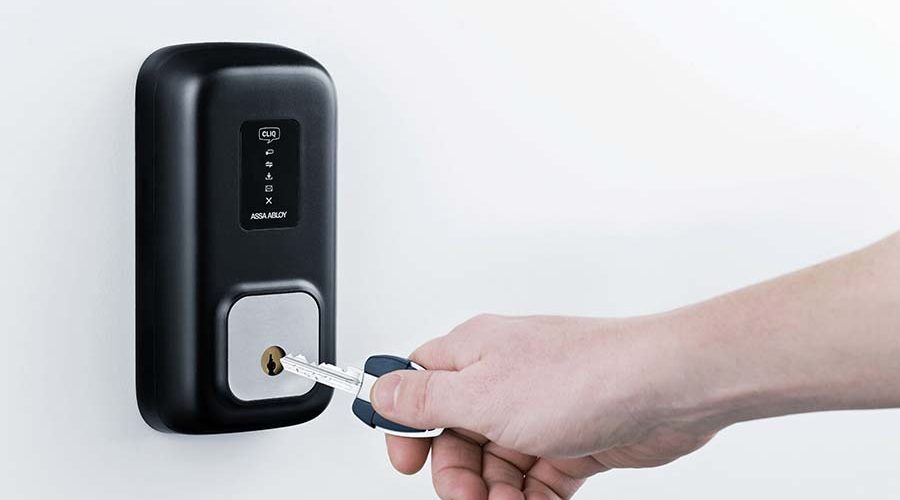One of the key current building challenges is how to reduce touchpoints throughout a site. Here, Richard Bromley, Business Development Director at the ASSA ABLOY Door Hardware Group, outlines the options available for decision makers in the public building sector.
ASSA Abloy
The right door hardware or access control can help to create a safe and secure environment for all building users. They help protect building users from the risks hidden on well-used, common surfaces, while ensuring only authorised individuals have access to certain areas.
At this time, reducing touchpoints throughout a building is a top priority for many. However, it’s important to note that nothing will ever better a thorough and routine cleaning schedule for a site’s doors and their hardware. Surfaces should be cleaned with a mild, non-abrasive anti-bacterial detergent and water solution, using a soft cloth. Then, using water and a soft cloth only, surfaces should be wiped to remove any remaining detergent residue. The treated surface should appear visibly wet then allowed to air dry. Various factors, such as frequency of use, levels of traffic passing through and security requirements, will all impact when deciding what cleaning routine is right for a building. Nonetheless, a regular cleaning regime is critical.
What other product solutions are available that can help reduce touchpoints throughout a public building?
Fast, low-cost options
Firstly, there are ‘touch-safe’ or anti-microbial products. These have been on the market for many years, offering a proven means of helping stop the spread of bacteria. Hardware treated with an anti-microbial coating can significantly minimise any risks, with copper offering both anti-bacterial and anti-viral properties. Copper alloy-based handles provide an effective and more permanent solution, but can be more costly. Alternatively, products such as anti-viral copper tape can be a good compromise. Quick to fit, this simply wraps around a clean door handle, providing a cost-effective, temporary solution.
While these measures do offer protection, it’s important to note these lose effectiveness over time, and so are not advised as permanent solutions.
Other options include arm and foot pulls. For those with only a limited budget available, these can be fitted quickly, enabling people to open doors without having to use their hands. Be aware, though; while these are quick, low-cost options, they can often invalidate the fire integrity of a door. They can also present a potential trip hazard if these protrude from a door too much.
Levelling up with door controls
The next step up would be to look at hold-open door controls, which can help keep doors open at all times, except in the case of an emergency. For instance, UNION offers Door Sense, a safe and legal means of keeping fire doors open, but which automatically closes should a fire alarm sound. There’s also ASSA ABLOY’s DC300G-HF door closer, which holds doors open in medium- to high-traffic corridors, but then closes automatically in the event of a fire.
It’s important to note that fire doors must always be fitted with a CE-marked door control. It should go without saying that fire doors must remain a top priority in public buildings; trying to reduce touchpoints throughout a building should never be an excuse to not conform with legal fire safety requirements.
Hands-free solutions
To eliminate any contact with a door whatsoever, there are a range of access control hardware devices that simply require the wave of a hand to open. An automatic door operator that uses proximity sensors can be an ideal solution for an entrance door to a building, for instance. These can be a more expensive option, but are an effective answer for main thoroughfares.
Decision makers could also opt for access control solutions that use personalised keys. Not only do these reduce potential touchpoints throughout a site, but personalised keys also simplify key management, while saving organisations valuable time and money too. Solutions such as ASSA CLIQ Remote, which is a mechatronic locking system that assigns access rights to a key, allows users to have their own personalised keys for all doors and eliminates the need to share keys.
Loughborough University, for example, is just one site that has chosen the ASSA CLIQ Remote system to help secure rooms and improve access control. The technology has been used in a range of different applications, from teaching laboratories and offices to plant control rooms.
Loughborough University can programme and update each key remotely, removing or granting access privileges for the key holder in real-time. This allows only those with the necessary authority at the university to enter a room. For staff that have access to these areas and then leave the university, their access rights can be easily removed by using the system’s web-based interface. Contractors can also be given time-limited keys, so any potential security risks are minimised.
Phil Sheppard, Senior Clerk of Works at Loughborough University, said: “For us, a big advantage is that its electronics effectively extend the patent of the key indefinitely. The system cannot be copied, which means ASSA CLIQ Remote provides a long-lasting access control solution. The audit capabilities of the system are also really useful, ensuring we know exactly who accessed a room, and when.”
Nevertheless, whatever the available budget and building demands are, there are solutions available that can reduce the likelihood of key touchpoints proving an issue. By considering the door hardware options available to them, decision makers can help make sure public buildings are hygienic and secure environments, ensuring everyone feels as safe and as comfortable as possible in these spaces.









